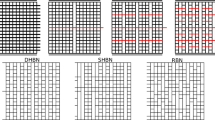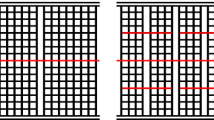Abstract
The paper demonstrates a rational design of an isotropic heterogeneous beam lattice that is fault-tolerant and energy-absorbing. Combining triangular and hexagonal structures, we calculate elastic moduli of obtained hybrid heterogeneous structures; simulate the development of flaws in that composite lattice subjected to a uniform uniaxial deformation; investigate its damage evolution; measure various characteristics of damage that estimate fault tolerance; discuss the trade-off between stiffness and fault tolerance. A design is found that develops a cloud of small evenly spread flaws instead of a crack.
















Similar content being viewed by others
References
Ajdari, A., Jahromi, B.H., Papadopoulos, J., Nayeb-Hashemi, H., Vaziri, A.: Hierarchical honeycombs with tailorable properties. Int. J. Solids Struct. 49(11–12), 1413–1419 (2012)
Berger, J.B., Wadley, H.N., McMeeking, R.M.: Mechanical metamaterials at the theoretical limit of isotropic elastic stiffness. Nature 543(7646), 533–537 (2017)
Bujny, M., Aulig, N., Olhofer, M., Duddeck, F.: Identification of optimal topologies for crashworthiness with the evolutionary level set method. Int. J. Crashworthiness (2017). https://doi.org/10.1080/13588265.2017.1331493
Cherkaev, E., Cherkaev, A.: Principal compliance and robust optimal design. J. Elast. 72, 71–98 (2003). (also in: The Rational Spirit in Modern Continuum Mechanics, Essays and Papers Dedicated to the Memory of Clifford Ambrose Truesdell III, 2003)
Cherkaev, E., Cherkaev, A.: Minimax optimization problem of structural design. Comput. Struct. 86, 1426–1435 (2008)
Cherkaev, A., Cherkaev, E., Leelavanichkul, S.: Principle of optimization of structures against an impact. J. Phys. Confer. Ser. 319(1), 1–16 (2011)
Cherkaev, A., Leelavanichkul, S.: An impact protective structure with bistable links. Int. J. Damage Mech. 21(5), 697–711 (2012)
Cherkaev, A., Cherkaev, E., Slepyan, L.: Transition waves in bistable structures. I: delocalization of damage. J. Mech. Phys. Solids 53(2), 383–405 (2005)
Cherkaev, E., Cherkaev, A., Slepyan, L.: Dynamics of structures with bistable links. In: Vibration Problems ICOVP 2005, vol. 111, pp. 111–122. Springer (2007)
Cherkaev, A., Ryvkin, M.: Damage propagation in 2d beam lattices: 1. Uncertainty and assumptions. Arch. Mech. (2017). (in print)
Cherkaev, A., Slepyan, L.: Waiting element structures and stability under extension. Int. J. Damage Mech. 4(1), 58–82 (1995)
Cherkaev, A., Vladimir Vinogradov, V., Leelavanishkul, S.: The waves of damage in elastic–plastic lattices with waiting links: design and simulation. Mech. Mater. 38, 748–756 (2005)
Cherkaev, A.A., Zhornitskaya, L.: Protective structures with waiting links and their damage evolution. Multibody Syst. Dyn. J. 13(1), 53–67 (2005)
Diaz, A.R., Bendsoe, M.P.: Shape optimization of multipurpose structures by homogenization method. Struct. Optim. 4, 17–22 (1992)
Diaz, A.R., Soto C.A.: Lattice models for crash resistant design and optimization. In: Proceedings of 3rd World Congress of Structural and Multidisciplinary Optimization, Buffalo, New York, USA, 17–21 May 1999
Fleck, N.A., Qiu, X.: The damage tolerance of elastic–brittle, two-dimensional isotropic lattices. J. Mech. Phys. Solids 55(3), 562–588 (2007)
Fuchs, M.B.: Structures and Their Analysis. Springer, Basel (2016)
Fuchs, M.B., Farhi, E.: Shape of stiffest controlled structures under unknown loads. Comput. Struct. 79(18), 1661–1670 (2001)
Grenestedt, J.: Influence of wavy imperfections in cell walls on elastic stiffness of cellular solids. J. Mech. Phys. Solids 46(1), 29–50 (1998)
Holnicki-Szulc, J., Knap, L.: Optimal design of adaptive structures for the best crashworthiness. In: Proceedings of 3rd World Congress of Structural and Multidisciplinary Optimization, Buffalo, New York, USA, pp. 17–21 (1999)
Holnicki, J., Knap, L.: Adaptive crashworthiness concept. Int. J. Impact Eng. 30(6), 639–663 (2004)
Kucherov, L., Ryvkin, M.: Flaw nucleation in a brittle open-cell Kelvin foam. Int. J. Fract. 175(1), 79–86 (2012)
Leelavanichkul, S., Cherkaev, A., Adams, D., Solzbacher, F.: Energy absorption of a helicoidal bistable structure. J. Mech. Mater. Struct. 5(2), 305–321 (2009)
Lipperman, F., Ryvkin, M., Fuchs, M.B.: Fracture toughness of two-dimensional cellular material with periodic microstructure. Int. J. Fract. 146, 279–290 (2007)
Lipperman, F., Ryvkin, M., Fuchs, M.B.: Nucleation of cracks in two-dimensional periodic cellular materials. Comput. Mech. 39(2), 127–139 (2007)
Lipperman, F., Ryvkin, M., Fuchs, M.B.: Design of crack-resistant two-dimensional periodic cellular materials. J. Mech. Mater. Struct. 4(3), 441–457 (2009)
Lurie, K.A.: Applied Optimal Control Theory of Distributed Systems, vol. 43. Springer, Berlin (2013)
Pedersen, C.B.W.: Topology optimization of 2D-frame structures with path-dependent response. Int. J. Numer. Methods Eng. 57(10), 1471–1501 (2002)
Quintana-Alonso, I., Fleck, N.A.: Fracture of brittle lattice materials: a review. In: Daniel, I.M., Gdoutos, E.E., Rajapakse, Y.D.S. (eds.) Major Accomplishments in Composite Materials and Sandwich Structures. Springer, Dordrecht (2009)
Salehian, A., Ibrahim, M., Seigler, T.M.: Damping in periodic structures: a continuum modeling approach. AIAA J. 52(3), 569–590 (2014)
Slepyan, L., Cherkaev, A., Cherkaev, E.: Transition waves in bistable structures II: analytical solution, wave speed, and energy dissipation. J. Mech. Phys. Solids 53(2), 407–436 (2005)
Soto, C.A.: Structural topology optimization for crashworthiness. Int. J. Crashworthiness 9(3), 277–283 (2004)
Zargarian, A., Esfahanian, M., Kadkhodapour, J., Ziaei-Rad, S.: Numerical simulation of the fatigue behavior of additive manufactured titanium porous lattice structures. Mater. Sci. Eng. C 60, 339–347 (2016)
Acknowledgements
The authors gratefully acknowledge support by the NDM, National Science Foundation, Award Number 1515125, and by Israel Science Foundation, Grant No. 1494/16.
Author information
Authors and Affiliations
Corresponding author
Additional information
This is the second part of a two-part paper that deals with the structural optimization of fault-tolerant lattices. We dedicate it to Konstantin Lurie, whose groundbreaking work in structural optimization inspires our continued investigations.
Publisher's Note
Springer Nature remains neutral with regard to jurisdictional claims in published maps and institutional affiliations.
Appendix. Calculation of effective properties of a hybrid lattice
Appendix. Calculation of effective properties of a hybrid lattice
Here, we compute effective Young modulus and Poisson ratio of the hybrid structures. Assuming that a constant horizontal strain is applied to the lattice (\(\bar{\varepsilon }_x= \varepsilon _0, ~ \bar{\varepsilon }_y=0\)), we calculate the horizontal stress component \(\bar{\sigma }_x\). The horizontal component of internal force in beam ij is denoted as \(F_{ij}\) (see Fig. 4). Positive sign of the force corresponds to tensile deformation. Due to the structural symmetry, it is enough to consider deformation of four beams: bending and extension of the inclined H- and R-beams and extension of horizontal H- and R-beams presented in Fig. 4.
The equilibrium of x-components of the forces in node 2 (Fig. 4) requires that
where \(F_{ij}\) is the tensile force in the beam that connects nodes i and j.
Two additional equations express compatibility conditions
Here \(u_{ij}\) denote the difference in the x-displacements of the ends of beam that joins nodes i and j. For the horizontal beams these values are expressed through Hooke’s law
where \(A_\mathrm{r}\) and \(A_\mathrm{h}\) are cross-sectional areas of h-beams and r-beams, respectively.
Deformation of the oblique beams consists of elongation along the beam and antisymmetric bending. Calculation by routine structural mechanics methods, see details in [17], gives:
Here \(t_\mathrm{h}, t_\mathrm{r}\) are relative thicknesses of h-beams and r-beams, respectively. Equations (18) and (19) allow for exclusion of \(u_{14}, \,u_{23}, \, u_{12}, \, u_{24}\) from (17), and Eqs. (16) and (17) allow to express \(F_{25}, F_{12}\) and \(F_{23}\) through \(F_{24}\).
The average over the cell stress in horizontal direction is the sum of these forces over the size of the cell’s period.
and the average deformation is the sum of elongations in two horizontal r-beams and one h-beam over the size of the period.
Using Mathematica, we obtain after some manipulations
Equations (9), (10), (22) yield to the sought expressions for the effective elastic Young modulus and Poisson ratio of the hybrid lattice
where
which agrees with formulas (11), (12). There, the moduli \({E_*}\) and \({\nu _*}\) are expressed through density \(\rho \) and ratio \(\alpha \) and parameters \(t_\mathrm{r}\) and \(t_\mathrm{h}\) are defined as
Notice that for the cases \(t_\mathrm{r}=t_\mathrm{h}=t\) and \(t_\mathrm{r}=0\), the above expressions yield the known formulas for triangular and hexagonal lattices, respectively, see [24].
Interestingly, the expression for Poisson ratio of the rhombic lattice (Fig. 2, center) is the same as for the hexagonal one, as it is evident from setting \(t_\mathrm{h}=0\) or \(t_\mathrm{r}=0\) in (23). However, the thickness of the beams in the rhombille lattice is twice smaller than in hexagonal lattices for the fixed relative density because rhombille lattice has twice more beams per unit volume.
Rights and permissions
About this article
Cite this article
Cherkaev, A., Ryvkin, M. Damage propagation in 2d beam lattices: 2. Design of an isotropic fault-tolerant lattice. Arch Appl Mech 89, 503–519 (2019). https://doi.org/10.1007/s00419-018-1428-0
Received:
Accepted:
Published:
Issue Date:
DOI: https://doi.org/10.1007/s00419-018-1428-0




